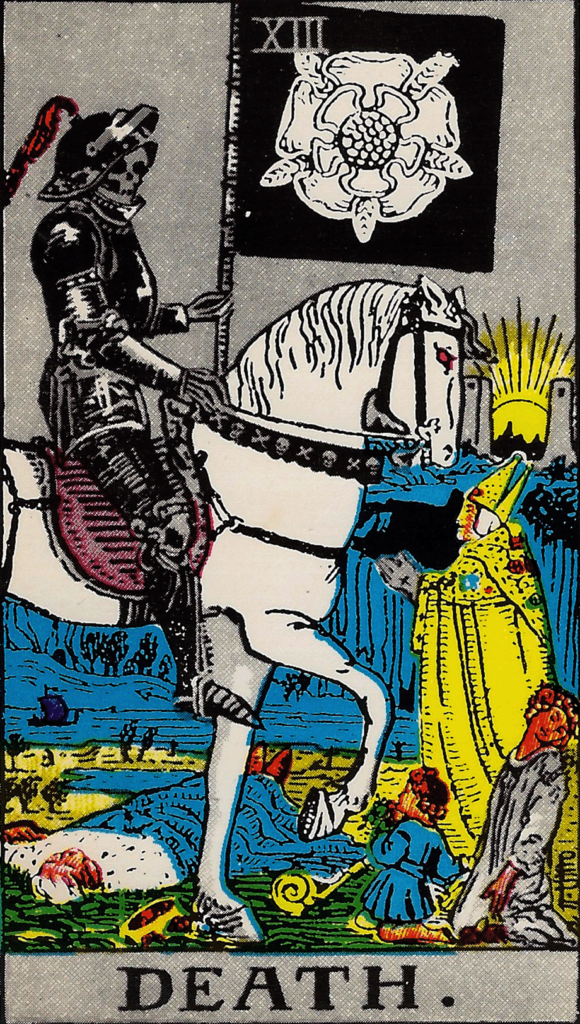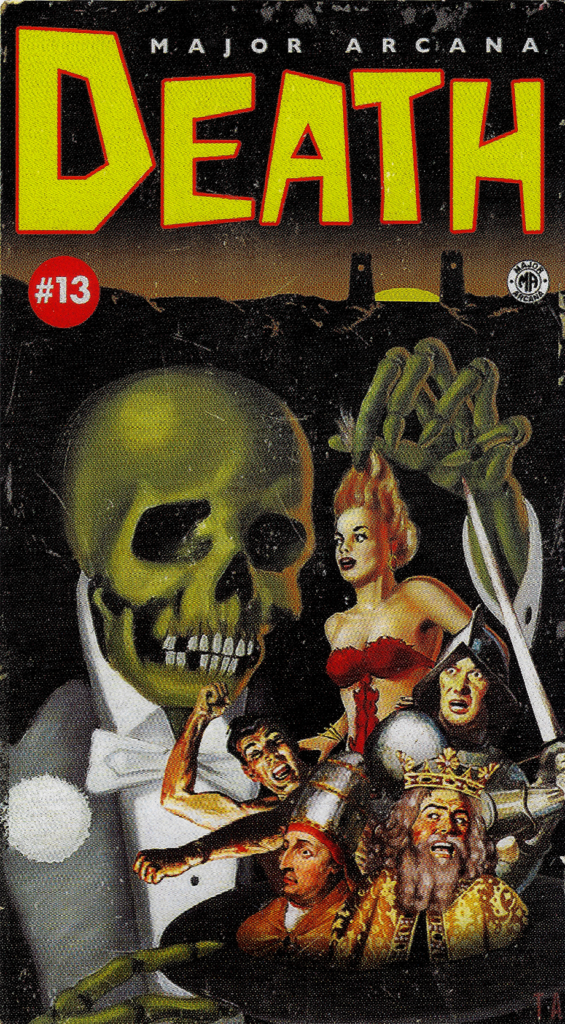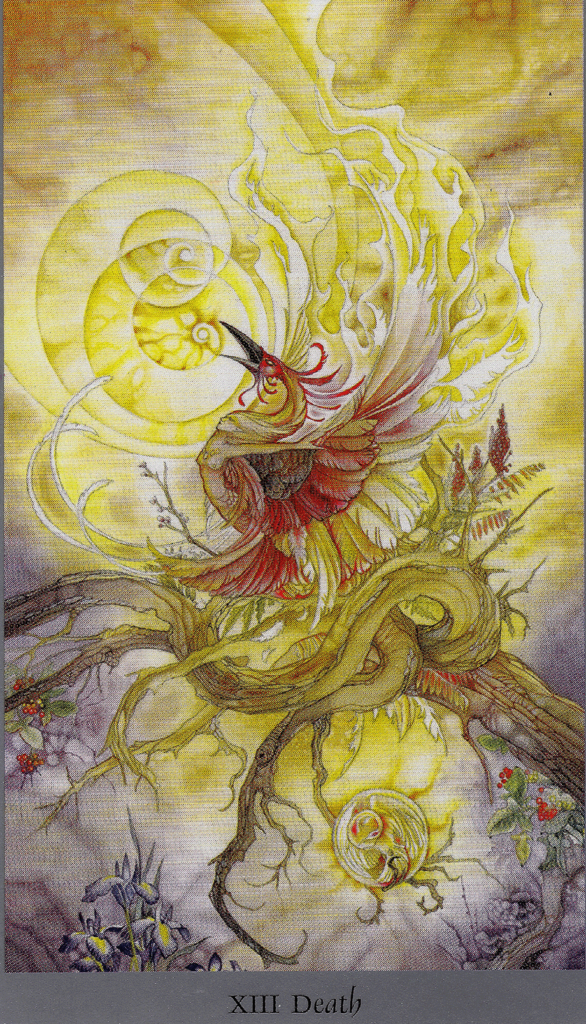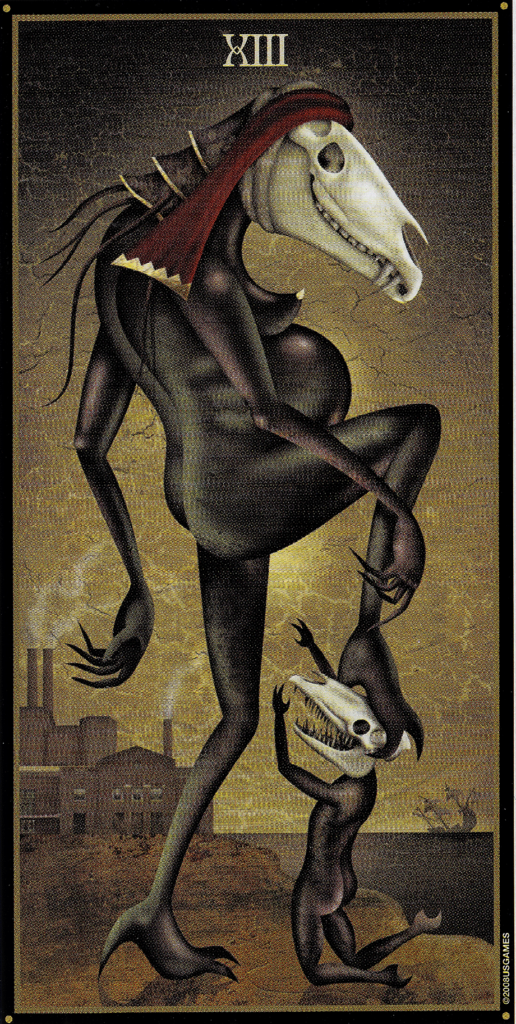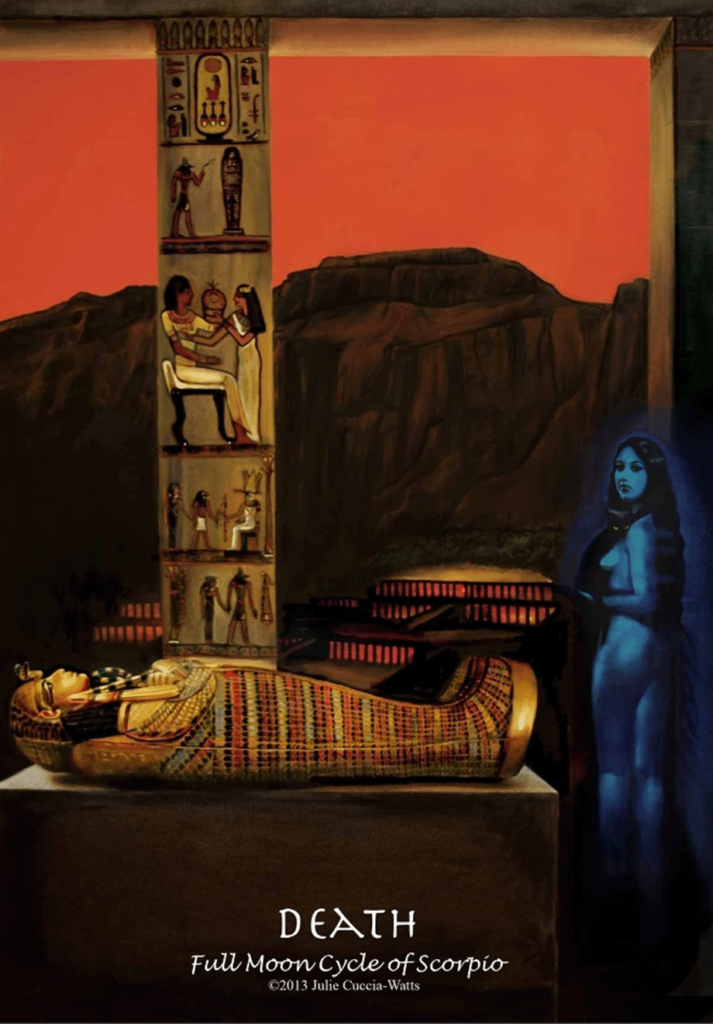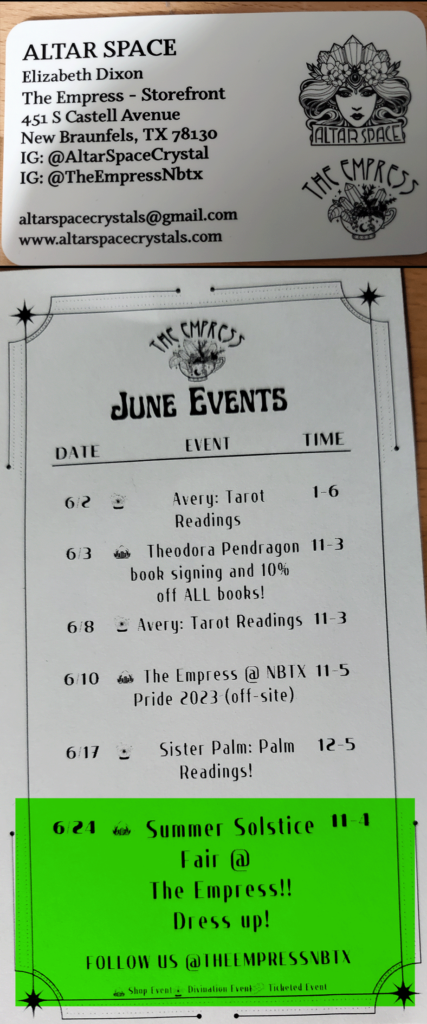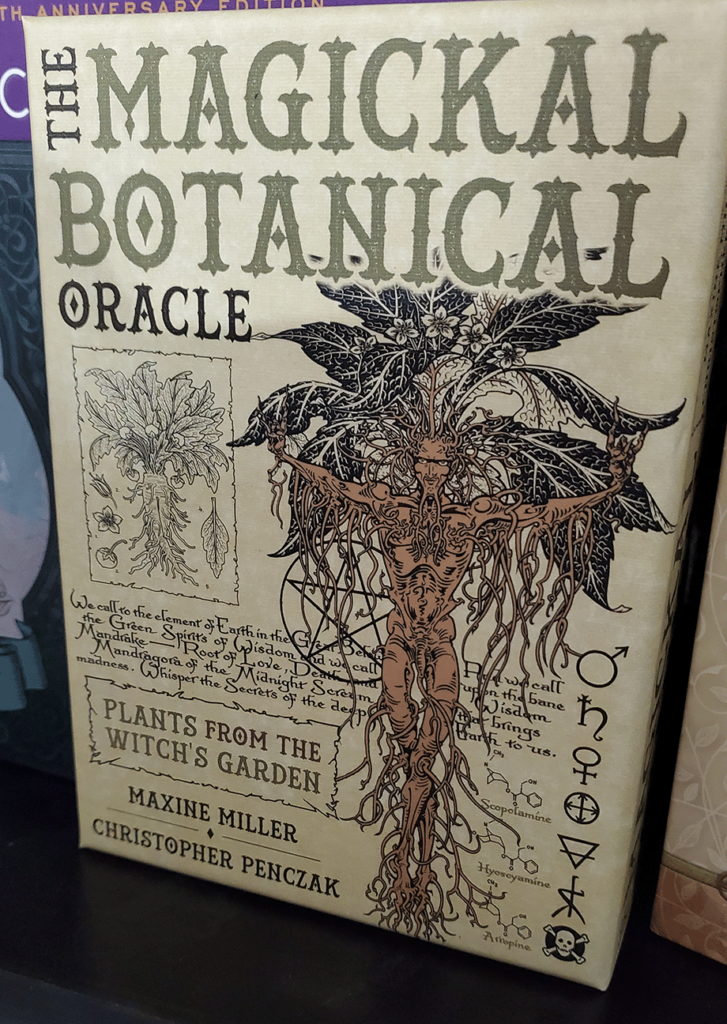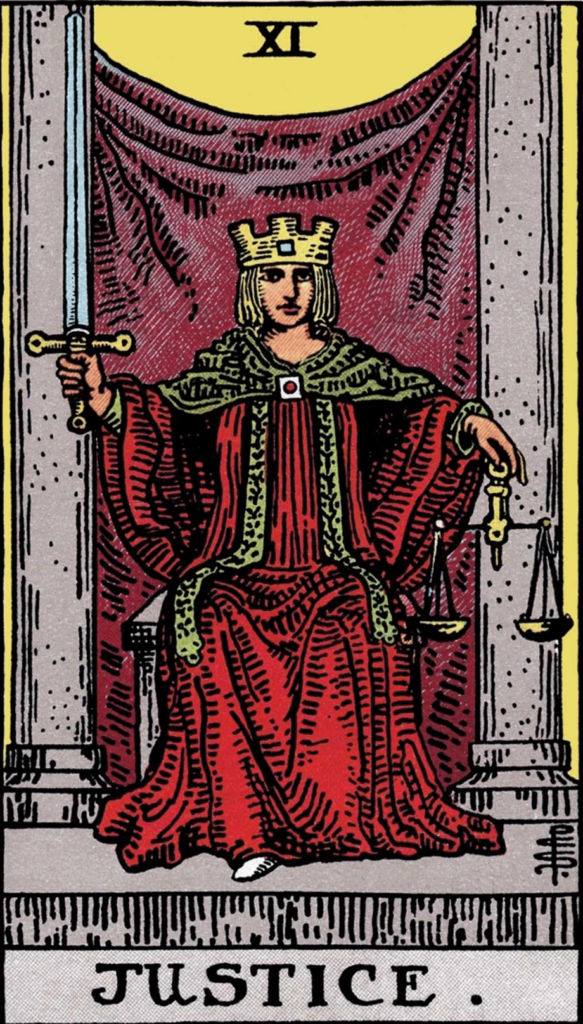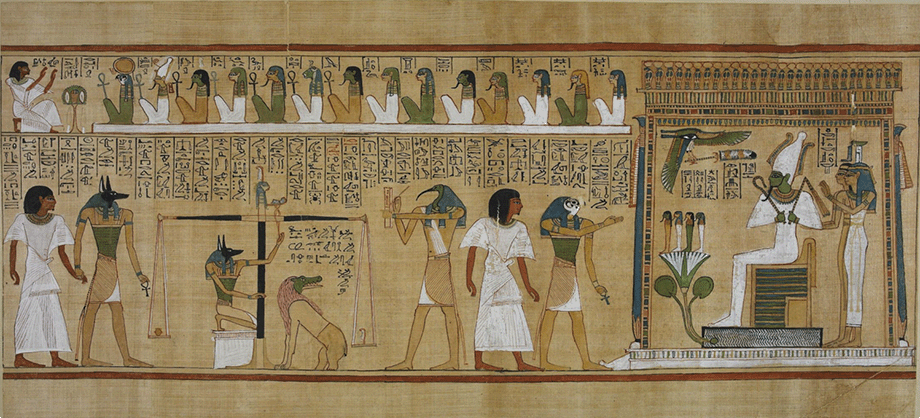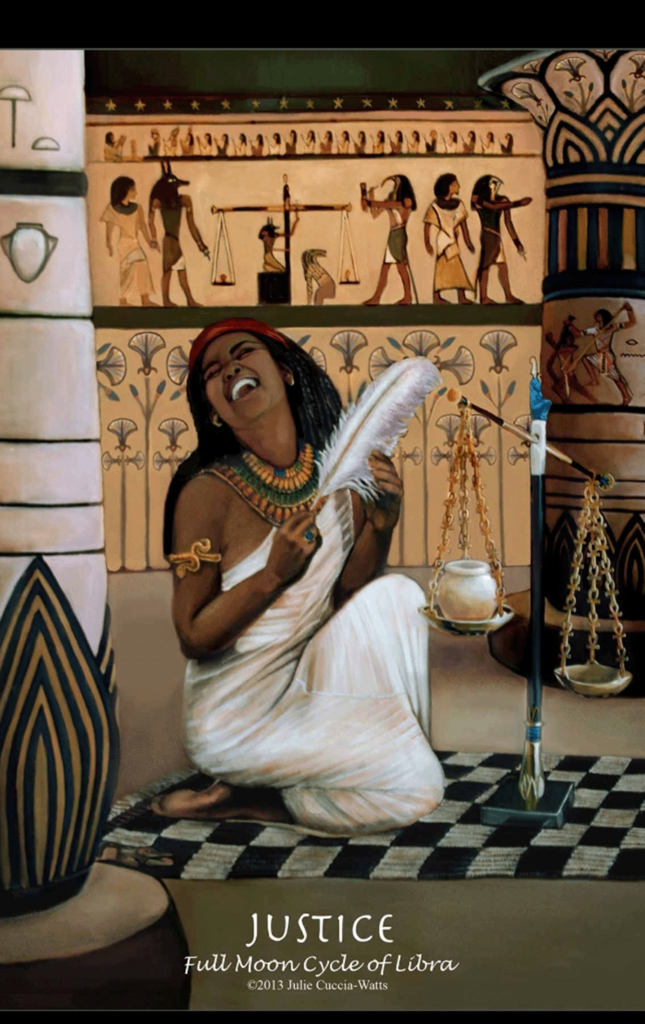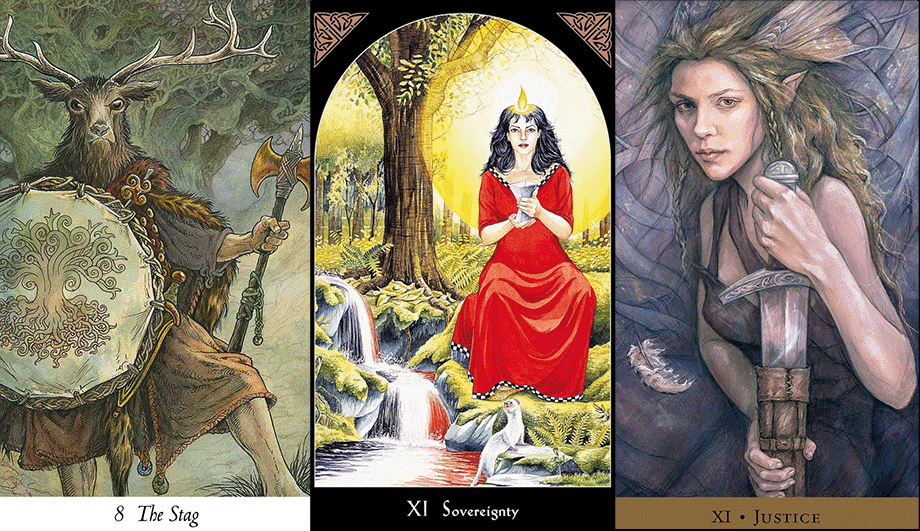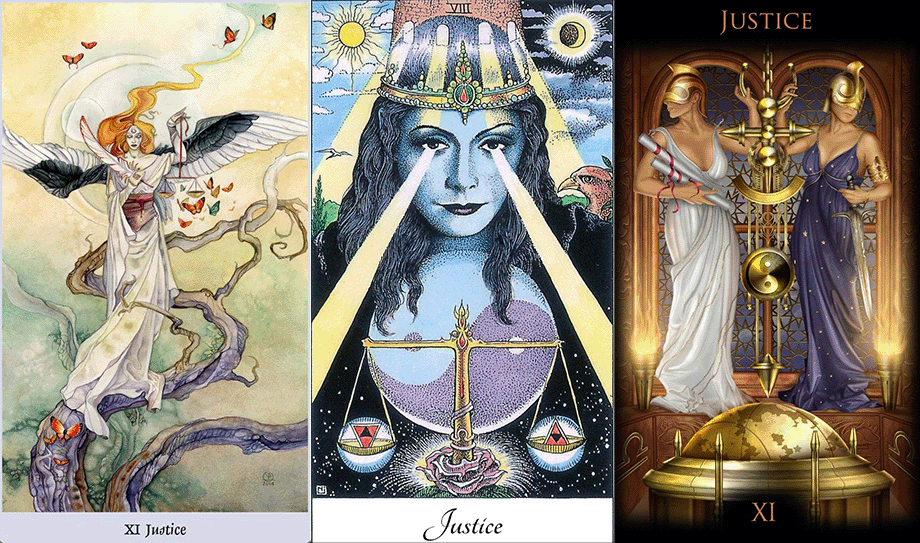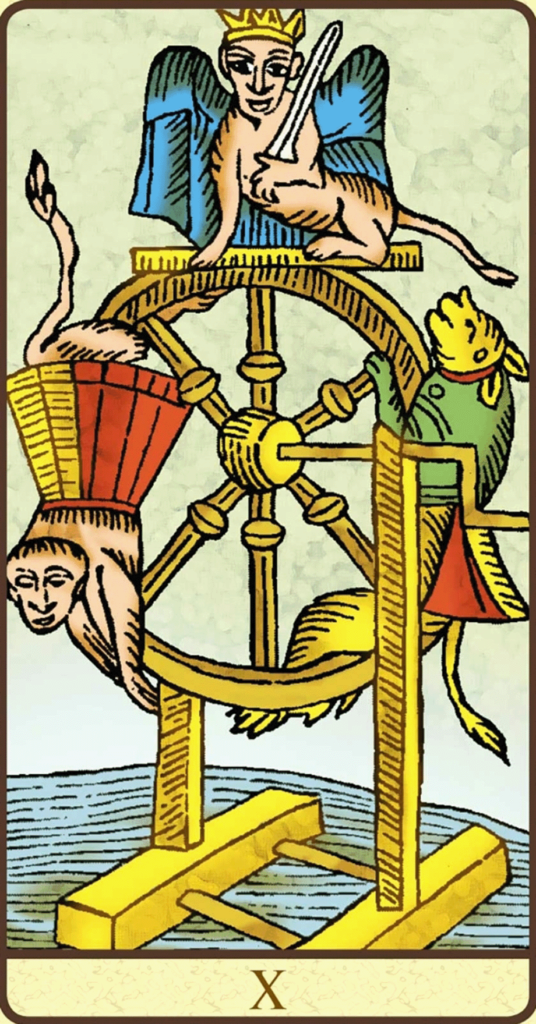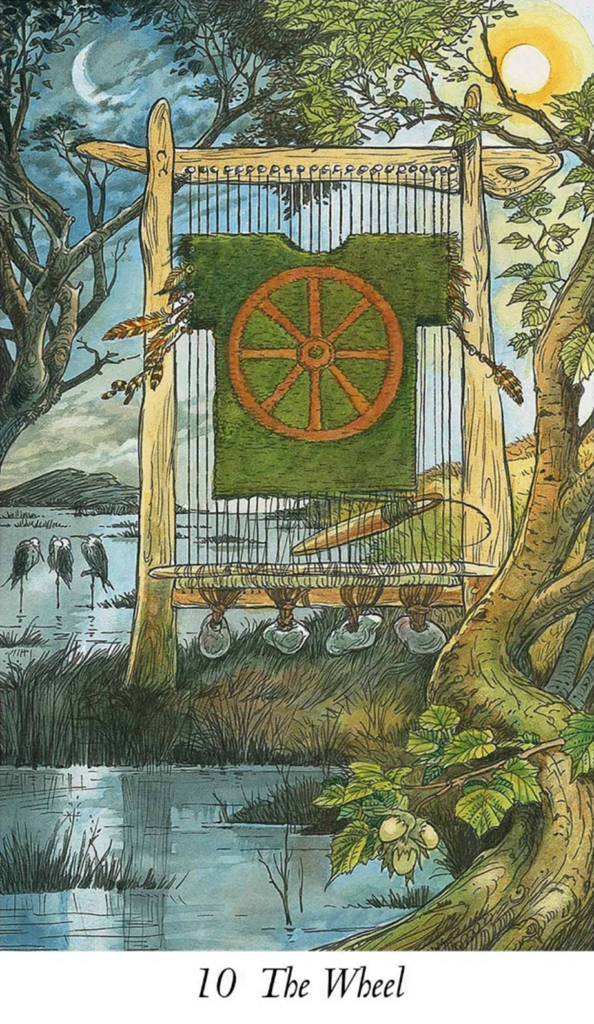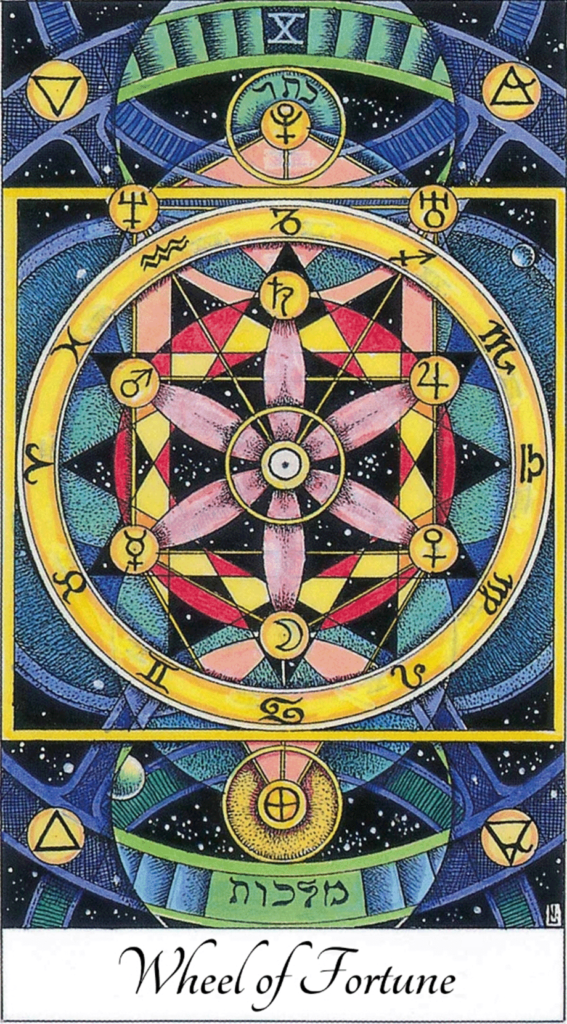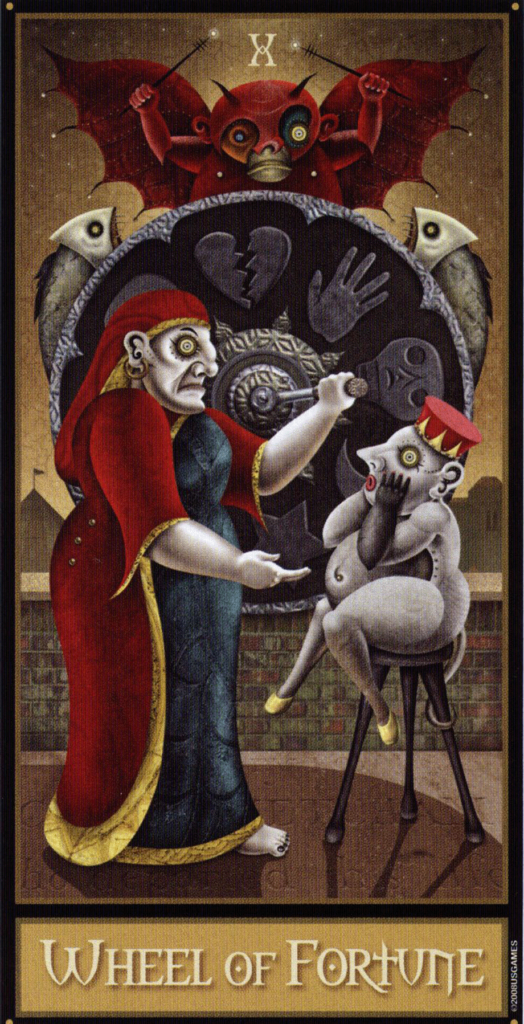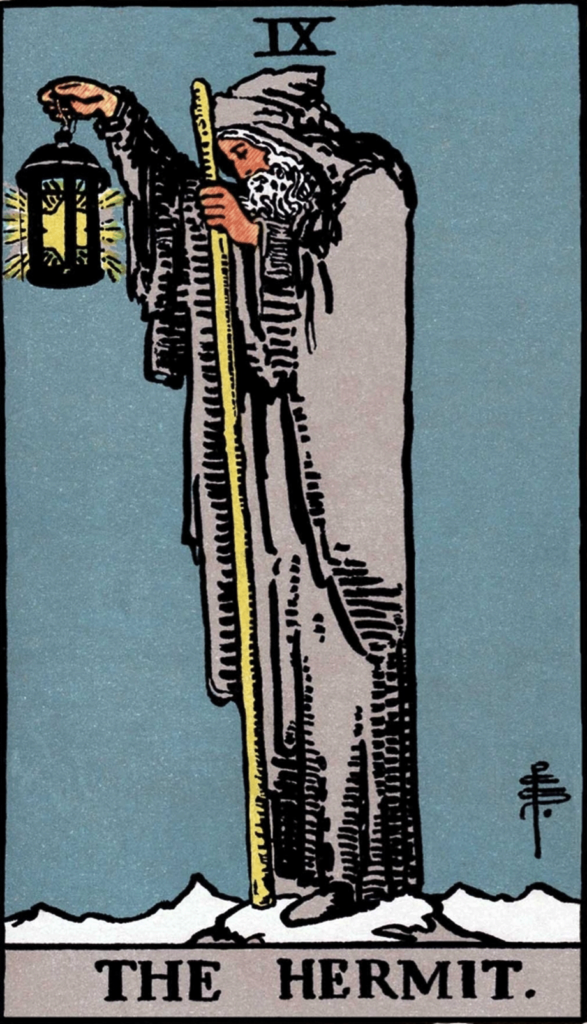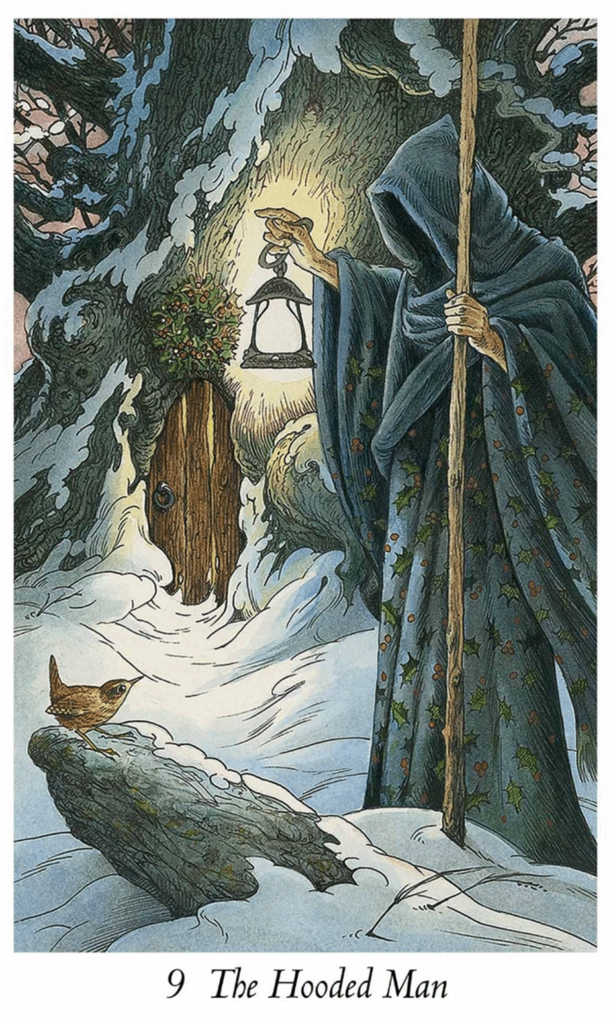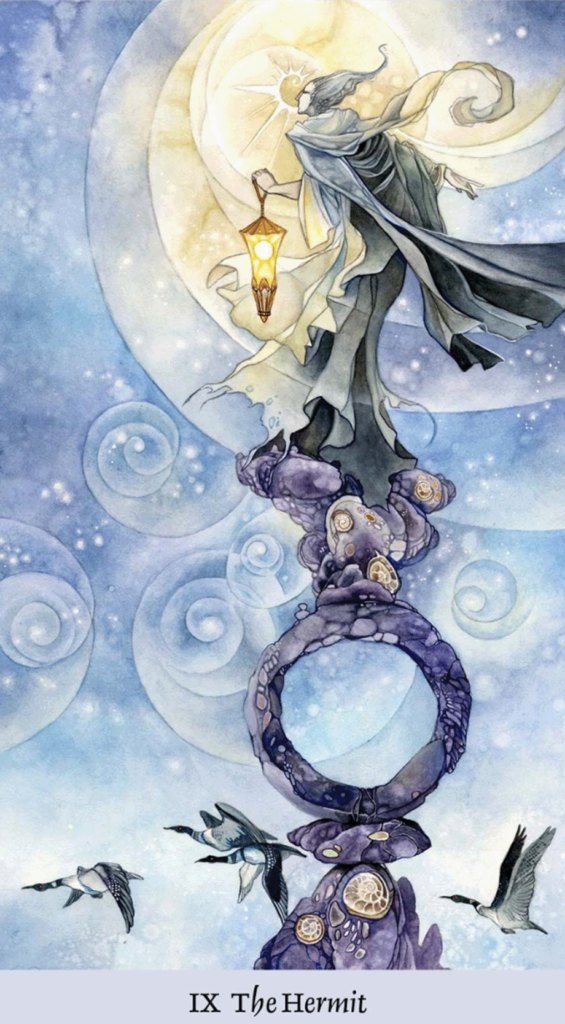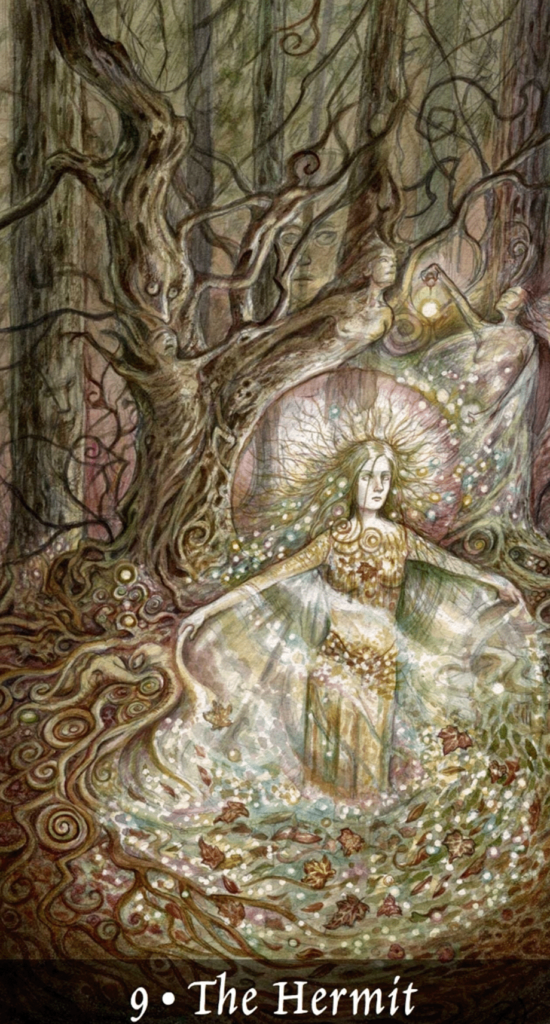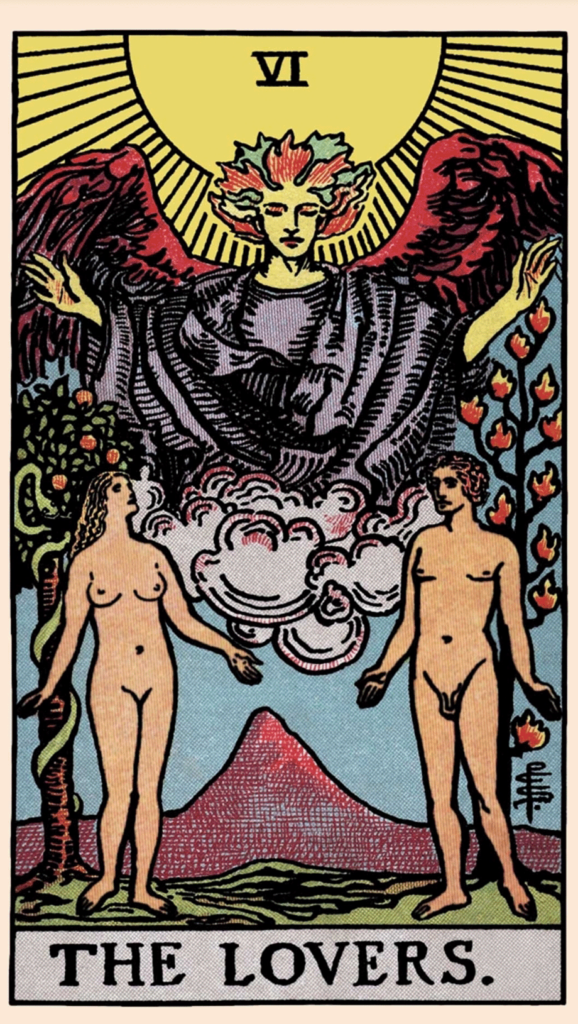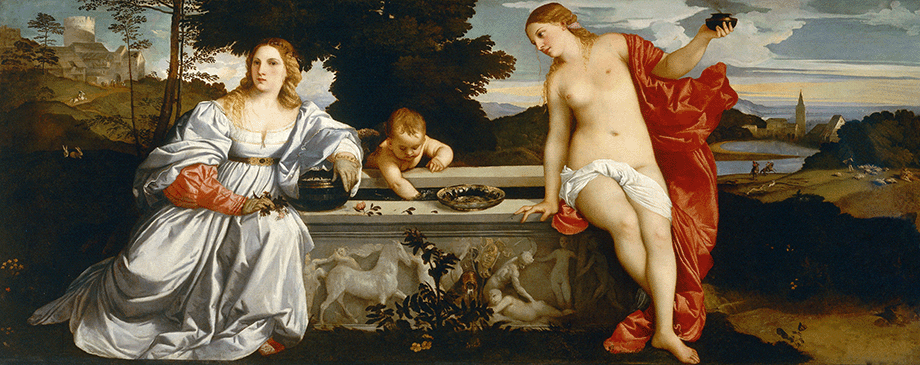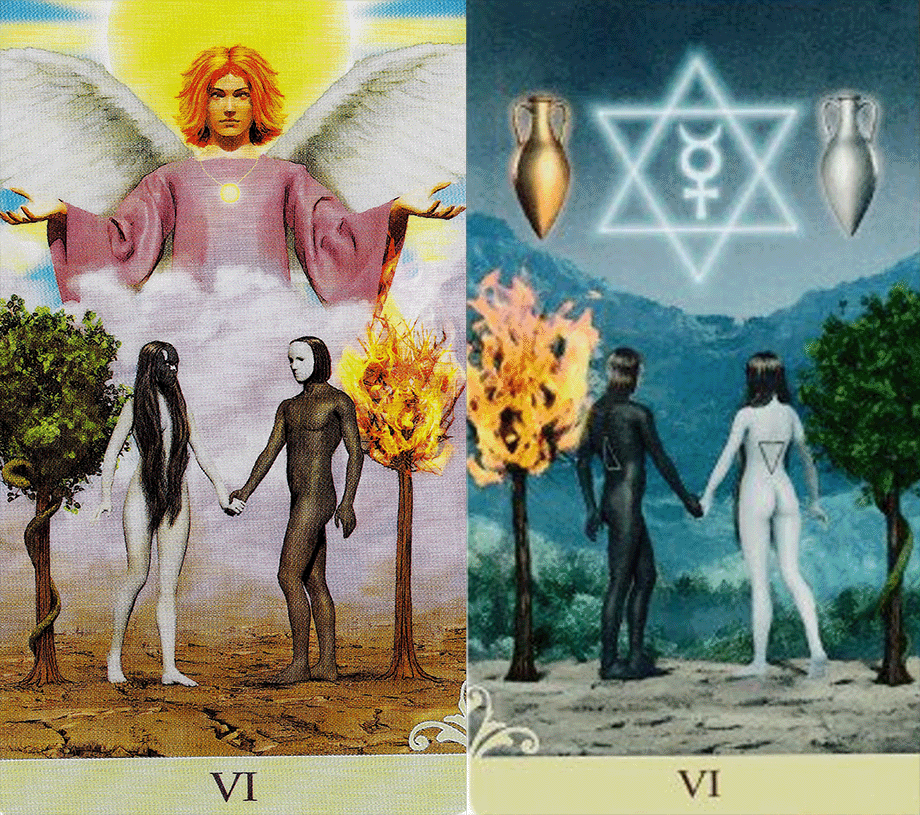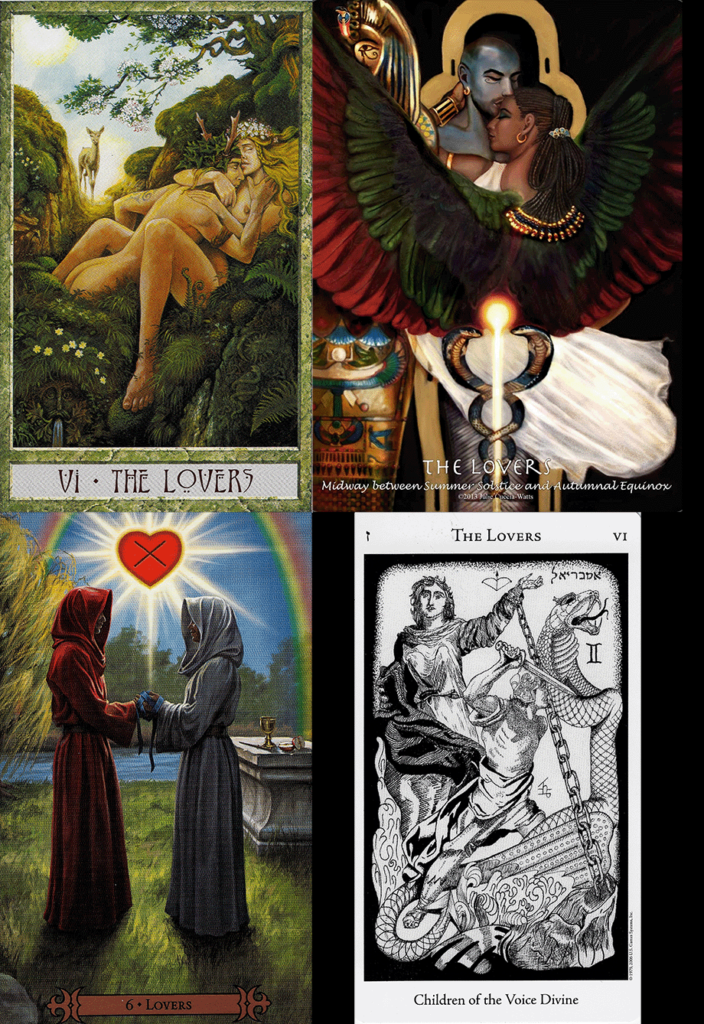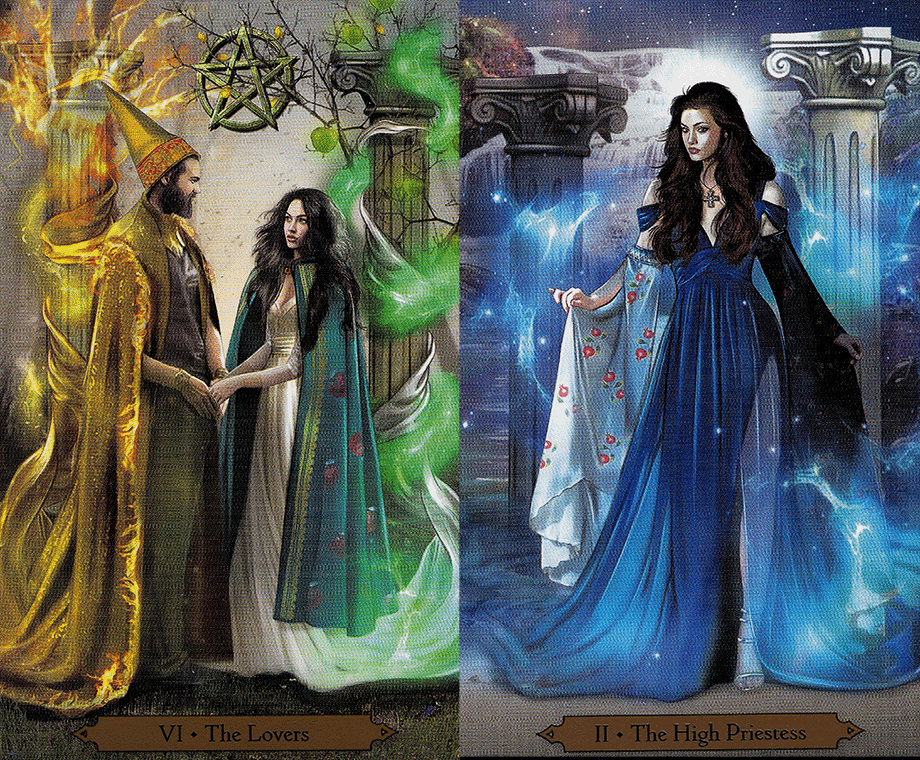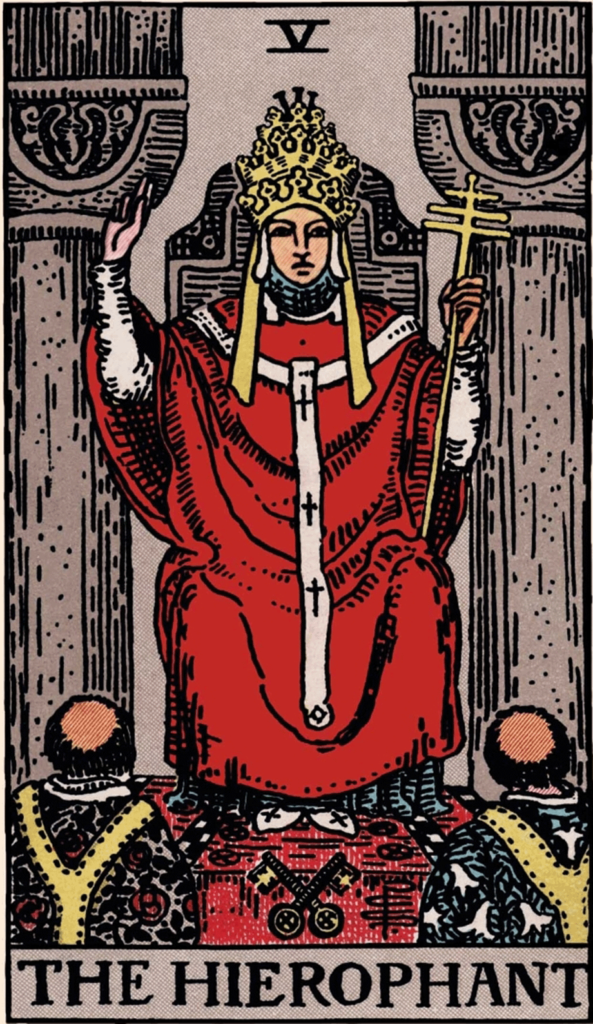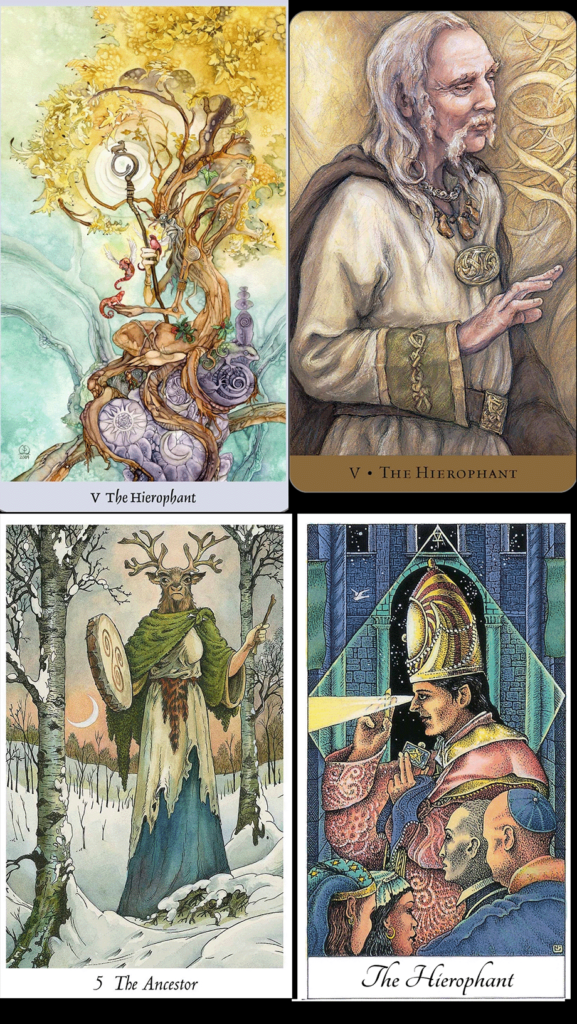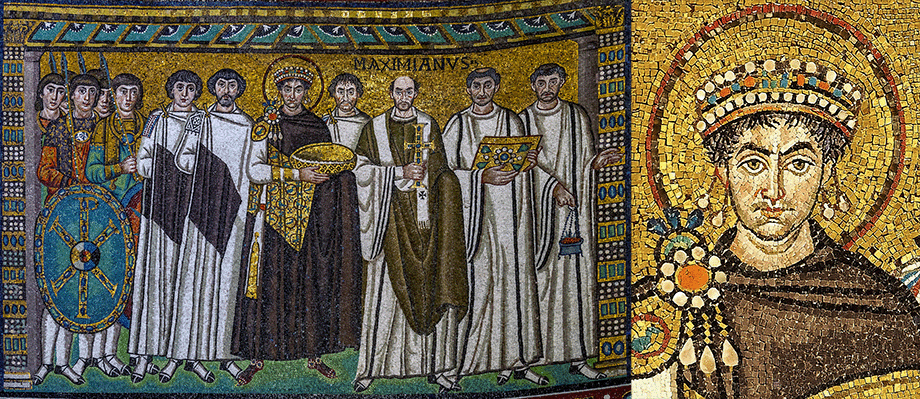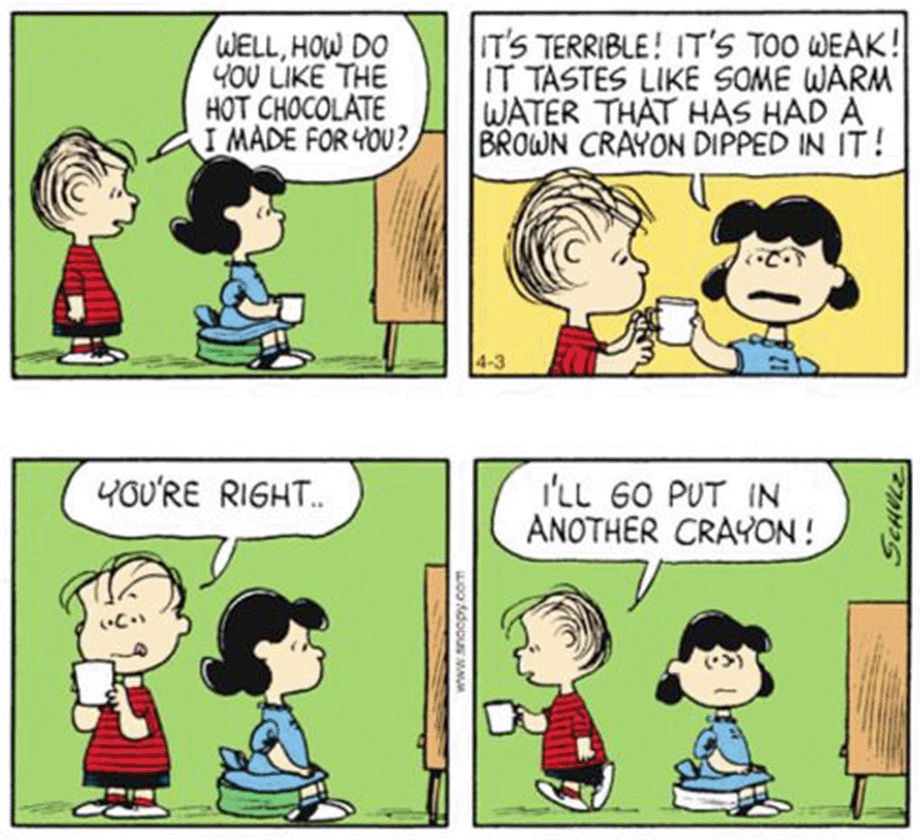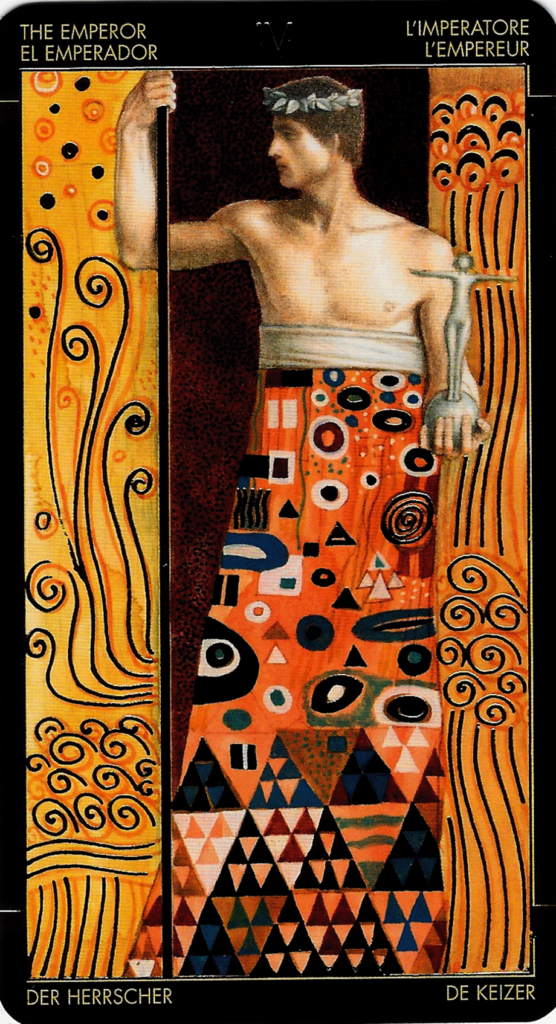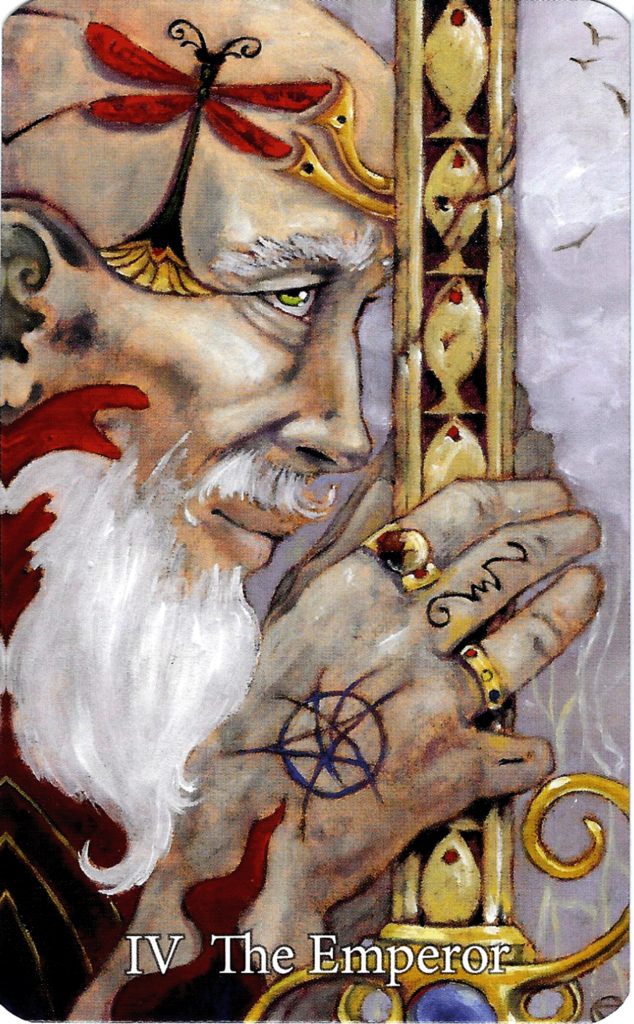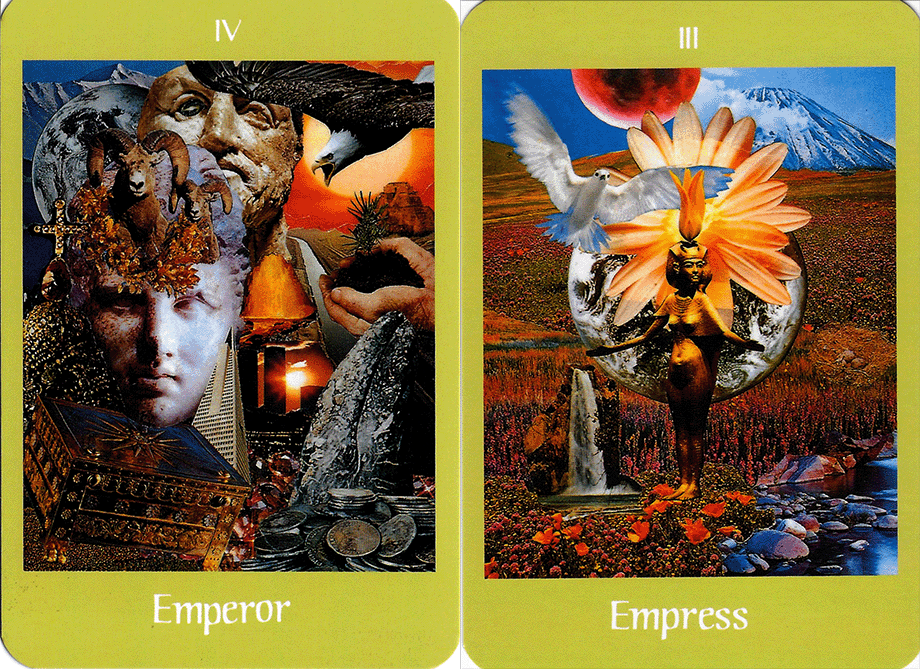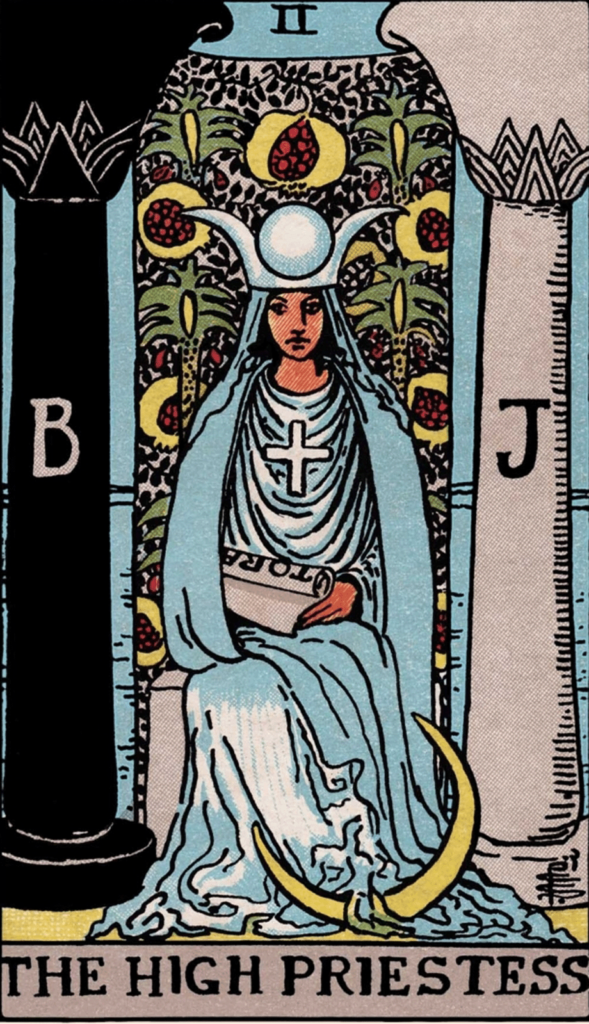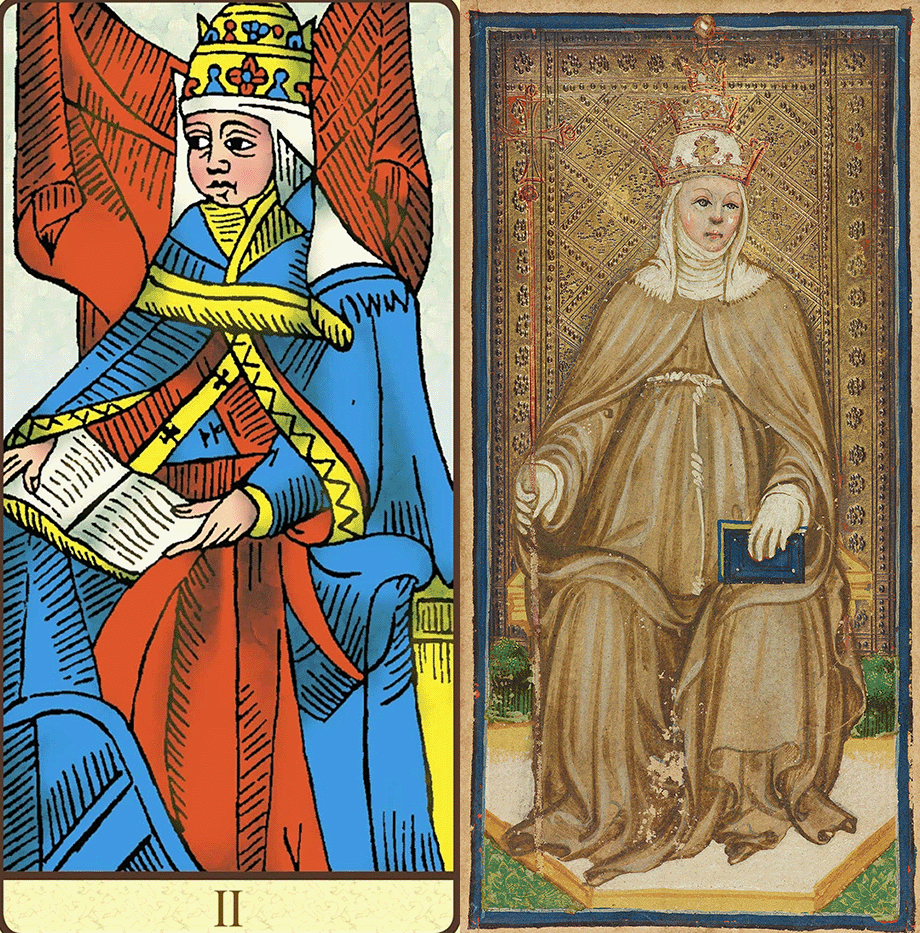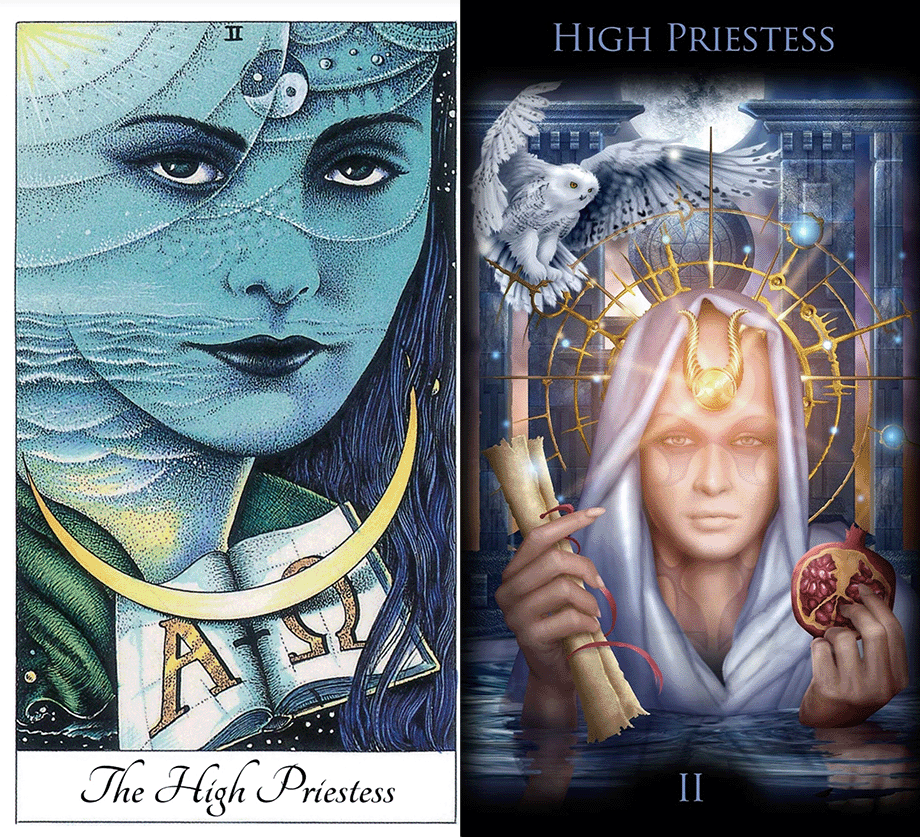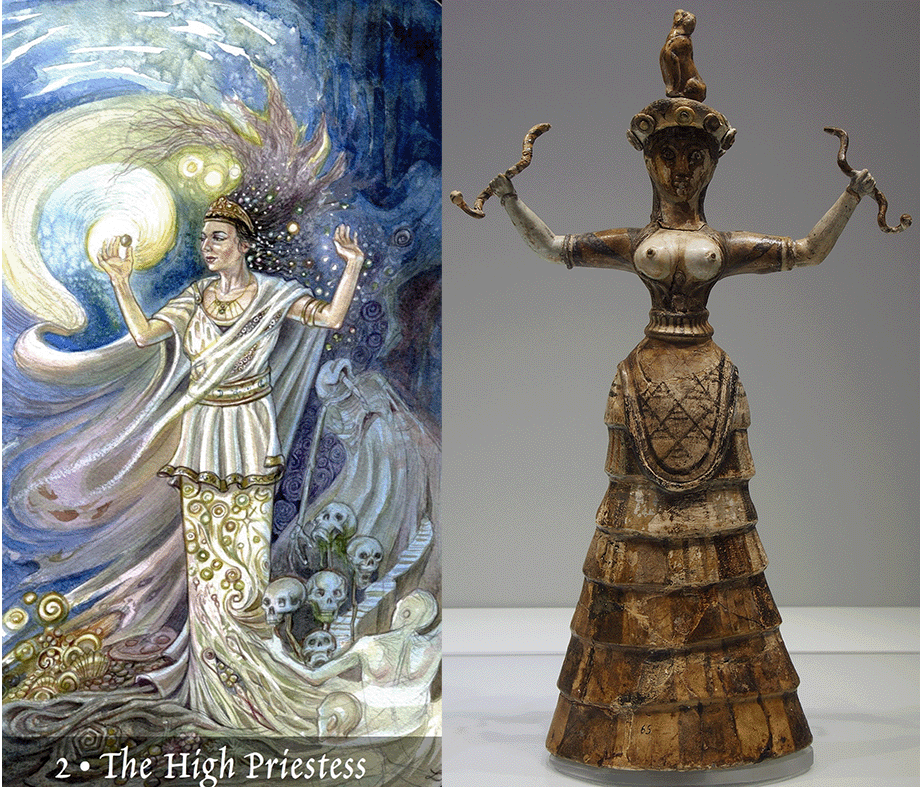Temperance makes its way into the Tarot deck as one of the old Catholic virtues. It’s place between Death and the Devil may be a bit more complicated.
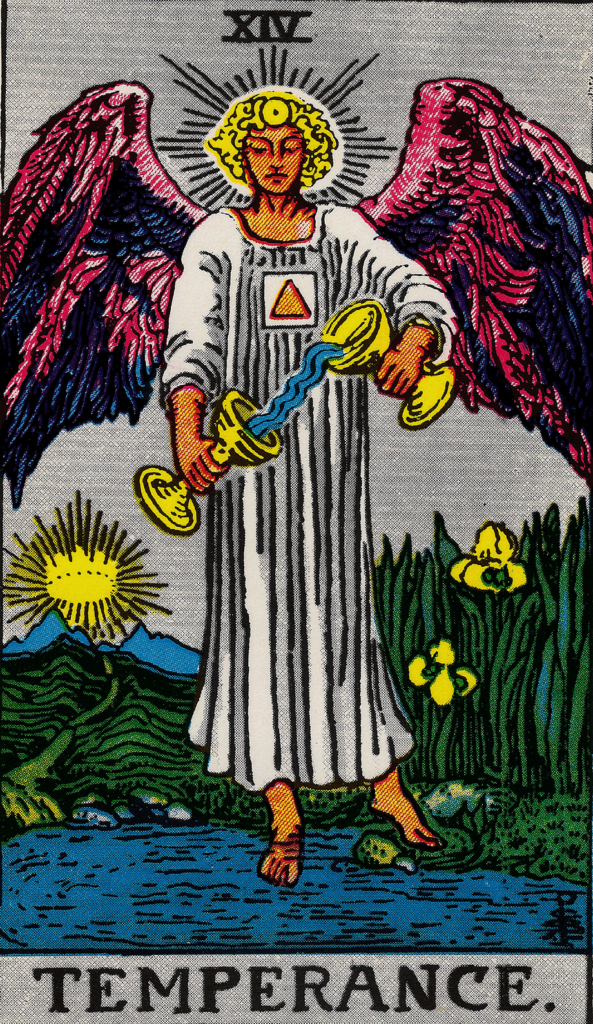
Card XIV as it appears in the Rider-Waite-Smith deck is an image of an angel, with large red wings, pouring what appears to be water, from one chalice to another. The path of the water is physically improbable, if not impossible, in that it flows diagonally rather than downward. The upper chalice is in the left hand of the angel, the lower receiving chalice in the right. The angel stands with the left foot on the land, and the right foot in the water. Behind the left leg is a field of flowers which have been identified by some as irises. To the right, it appears that there is a path rising up out of the water and passing backward to a gap between two mountains, above which a luminous crown rises. The angels own halo is defined simply by rays emitted from it’s head (the gender is not specific) On it’s brow is the solar symbol, that goes back to the name of Ra in hieroglyph, and on the breast is a square with an orange triangle in it. The sky is the same gray as the previous Death card. The distant mountains are a light blue (the same color as the water, actually). The water contains ripples that indicate it is a small pond, or an inlet, rather than a flowing stream.
Much of the imagery here is echoed in the Star just a few cards later. There is that same symbolism of two vessels, and also the connection between the dry land and the water. The difference is that the Star is pouring out the contents of her pitchers onto the land and the water, whereas Temperance is pouring from one to the other, or possibly mixing the two. Yet the Temperance angel is linking the earth and the water in its stance.
Temperance taken at face value signals that balance one strives for, in order to have some general control over one’s fate. Of course, we’ve looked at the balance idea with Justice, so there seems some redundancy here. Justice also derives out of those ideas of the cardinal Catholic virtues, and forms a tetrad with Strength, and supposedly the Hermit, representing Prudence. If read as a Catholic virtue (and this is probably the likely origin of the name) then the mixing of materials here likely represents the dilution of the wine with water that takes place as part of the Eucharist ritual . This practice is, according to dogma, symbolic of the dual nature of Christ. The water represents his humanity, the wine his divinity. Thus it may be seen as a metaphor for the spirit of the divine that incarnates in all humans.
If this is a symbol of the Eucharist, then the angel is most likely identified as Michael, who is most often confounded with Christ in much of the mystical literature. It is Michael who is chief of the armies of heaven, and who makes the final war against the rebel angels and the Great Dragon in the Book of Revelations. This has led many church writers to consider him identical with the risen and ascended Christ, who will come at the end of days (more about that later).
Paul Huson, in his seminal text Mystical Origins of the Tarot, suggests that this figure may have originally been meant as Ganymede, the cup bearer of Zeus. But this is also the source for claiming that Temperance derives from the Catholic virtues, so there may be a bit of conflicting information there. Not that this is unusual at all for mystic thought. And I am certainly not criticizing this text or Mr. Huson’s long work on the subject. I include it here merely to illustrate that the figure of the angel may represent a number of things. There is another reading that has the figure represent the goddess Iris (hence the flowers) who was emblematic of the rainbow and another messenger from the gods. There would seem to be a common theme that the card offers us some sort of insight, or perhaps indicates that maybe we should pay more attention to what is going on.
In my thinking this card’s symbolism is very much drawn from the practice of alchemy. If one is familiar with the fantastic and surreal rebuses used in the alchemical manuals, they’ll no doubt spot some of the similarities. Admixture of fluids is the most obvious one, but the symbolism of “betwixt and between” shown in the figure standing on both earth and water, is a frequent theme. The triangle on the chest of the angel gives us the element of fire, so we are only lacking air in this combination. Or perhaps we are supposed to leave out air. In alchemy there were often procedures that needed to be cooking in a sealed vessel, or allowed to “swelter” over time.
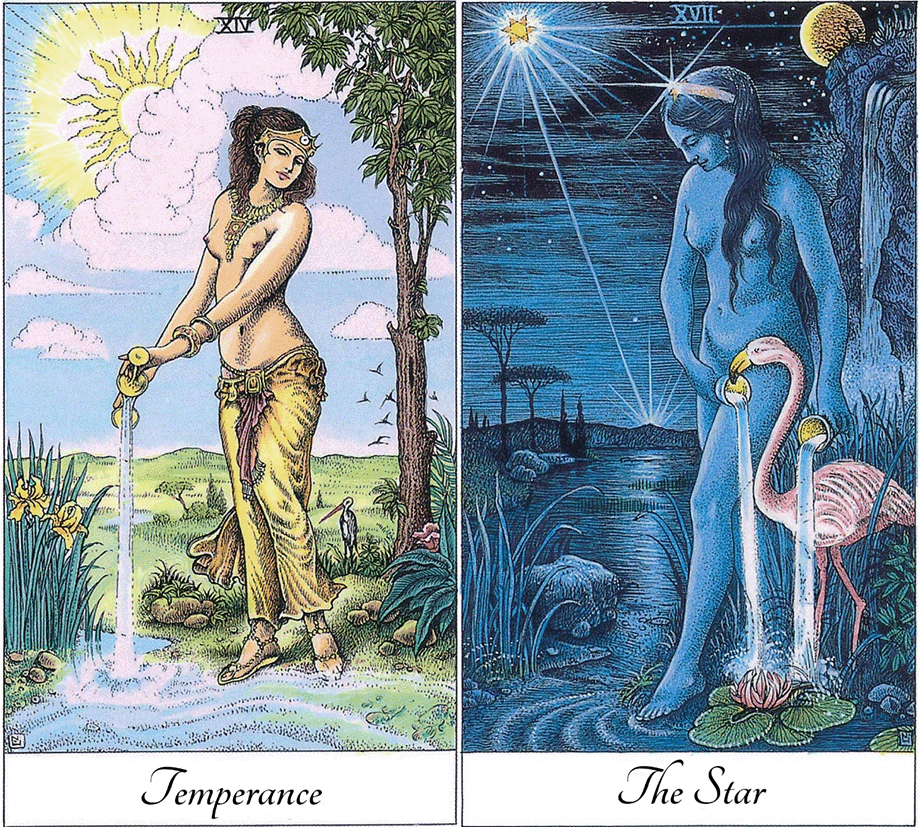
We may also see in this the dual nature of the Philosopher’s Stone and the Elixir of Life. These were the ultimate goal of alchemy, and though apparently two things, they were frequently interchangeable. They granted eternal life, youth, health, and wisdom, and possessed the power of transmutation. Not only could they turn base metals into gold, they were capable of elevating, or refining, anything to which they came in contact with. They drove out all corruption, and made the thing pure. One was the watery form of the earthy form of the other. Depending on the text, the silvery white powder of the Stone would dissolve into water (or wine) and make the Elixir, or the Elixir could be evaporated to precipitate the Stone. Essentially if one had the one, they could obtain the other.
This curious property echoes the idea of transmutation itself, and I think we can apply these insights when reading the Temperance card. We are not, here, bound by this idea of limitation. Once might basically presume the inference of this card is that of stopping before things get out of hand. But rather, we can look at it terms of controlling our choices, not merely just holding back. Consider the alchemical idea of refinement, of incorruption, of the removal of impurities. Alchemy used the processes of improving an ore or an alloy as metaphor for spiritual growth. In fact, the adept had to attain a certain purity of spirit before they would be able to create the key chemical combinations that would result in the Philosopher’s Stone. Some mystics suggest that the true adept was able to perform the miraculous feats of changing lead to gold and living a prolonged life because they had completed this internal alchemy, and that the external Stone or Elixir were merely metaphor. The adept became capable in their own power, much as we see things like reiki today, of making these astounding changes.
That crown rising in the distance, is, to my thinking, a symbol of the personal power that can come from self-control, self-discipline, and self-knowledge. We can make the water defy gravity if we have sufficient control of our own will, and sufficient awareness of the world around us. We have to stand on the land and the water. To understand both the mundane and the sublime we need to be as at home in that watery world of the unseen, as we are on the dry land of objective reality. The “crown” is a common term in alchemy texts, and representing stages of the refinement practice which result in purer or purest material.
I admit that much of my thinking probably was influenced by exposure to Crowley’s Book of Thoth version of this card in my early twenties. That card is call “Art” and very directly expounds on the alchemical ideology. In the Thoth version, two conjoined figures pour fire and water into a common cauldron, presided over by a white lion and a red eagle. The figure may be considered hermaphrodite, as it shows a union of opposites, a very common depiction in alchemical art.

This is the culmination of those aspects we see in the gendered metaphors of the earlier trumps of the Major Arcana. The figures are an equal union. There is therefore none in dominance, but a true blending of the properties of both, that is necessary for the creation of the Elixir. It is an awareness that all things are but aspects of one thing, that the outward forms are only meant as a means of understanding the inward truths, that is required to refine the Stone. And the Stone and the Elixir are the same thing. One within the other, one giving birth to the other, in an endless cycle. This is also the structure of the second riddle of the Sphinx, the answer to which is “day and night” but may more generically be termed “time”. And remember that the most astounding power of the Stone/Elixir is eternal life.
We can spin this right around to the Christian iconography we talked about at the beginning. If we are seeing the angelic figure as the risen Christ, performing the sacrament from the Last Supper that supposedly absolves the sinner and makes them worthy to enter the Kingdom of Heaven, then this cards connection to immortality is rather obvious. We can see that crown over the horizon at the end of the long road as the promise of Paradise.
Alchemy, despite it’s well established connections to magic, or at least magic results., was essentially cooked up in a Christian context. While it may have been inspired, or even educated on pagan texts, medieval grimoires, and possibly dicey translations of ancient Hebrew and Islamic works, any underlying spiritual transformation was clearly cast in the Catholic mold. While it’s true some alchemists, and the associated seers and necromancers of the Renaissance and early Enlightenment were prosecuted by varying authorities on crimes of witchcraft, most often it was their failure to produce results, in the form of eternal life, health, and wealth, that led to their ultimate demise. Alchemy as a practice survived well into the 18th Century, where it was practiced by no less a personage than Sir Isaac Newton. Newton’s laws, which formed the basis for physics for centuries and still apply to certain large massive operations of gravity, are prefaced with his understanding of a “spiritual architect” that derives from alchemical ideas.
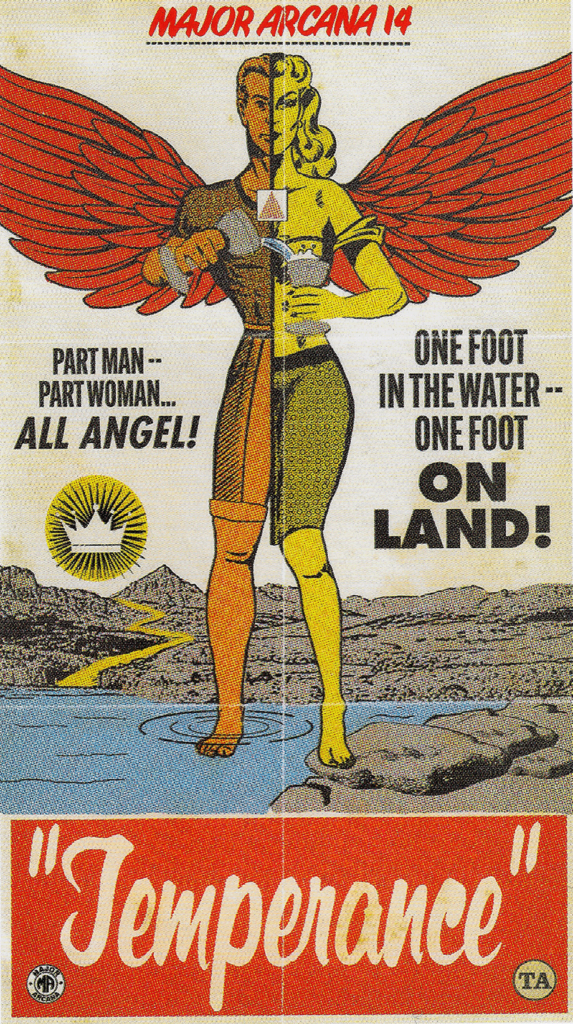
One of these contexts is that Jesus Christ transforms the wine and water into the Elixir of Life. It is through his personal divinity that this transmutation occurs, and it is through this power, passed down the ages from the disciples to the various popes to their bishops and priests, that the Holy Eucharist conveys this eternal life in the ritual of the mass.
Yet the idea of the alchemist is that this is a natural process, which may be discovered, attained, and passed on, without necessarily having intervention of deity. Or rather, that it did not require the involvement of an established church and the Apostolic Succession. There is no coincidence that the flowering of alchemy and the Reformation are closely aligned in history. While much of the material theories predate Christianity, it is during that period when the pre-Christian knowledge of the Graeco-Roman world was re-emerging to challenge the dogma of Catholicism that sees it blossom.

The left image is from the Wildwood Tarot, and features the Red and White dragons from the child Merlin’s vision. In the story, King Vortigern is trying to build his new fortress, but it keeps falling down. The augers say a child must be sacrificed, and the young Merlin is selected. He tells Vortigern that he must dig down into the foundations of the hill to release the two dragons, so that the ground will stop trembling. He does and the castle gets built. This legend is later embellished with Merlin’s half-human or non-human ancestry, and attached to the Red and White Wells of Glastonbury, on whose hill the bones of Arthur and Guinevere are supposed to have been found. Vortigern is considered to have been an historical personage, and the account places him some time before Ambrosius and Artorius, who may have been the historical source for Arthur. Merlin or rather Myrdwn in Welsh, if the same person in both stories, would still have been well over two centuries old.
The Image on the right is from the Arthurian Tarot, which is an amalgam of old Celtic myth, Grail lore, Arthurian fiction, and a handful of Saxon/Norse referents, as well as some later glosses from the English witchcraft revival. Her we see three women tending a cauldron. They represent the more modern ideas of Maiden/Mother/Crone that may not have good evidence of existing in antiquity. There are a number of magic cauldrons in Celtic myth. There is the Cauldron of Bran, which the Irish High King used to raise his slain warriors to fight again another day. The Cauldron had a number of other magical powers, such as providing an endless supply of food and drink, and being able to determine if someone spoke the truth. Much of these powers were confuted with the Grail in later chivalric tales, but they originate in the Mabinogian.
The other famous Celtic cauldron is that of Ceridwen, who made up a mystic brew to give her son (who was no great shakes) a fair form and powerful wit. She hired a man named Gwion Bach to stir it, and at the appropriate hour, when the charm was complete, the cauldron burst and three drops of the contents landed on Bach. He immediately became a powerful sorcerer, and there follows the tale of a wizards duel where Bach flees Ceridwen and they each go through a variety of transformations. In the end, Bach becomes a grain of barley, and Ceridwen transformed into a hen, eats him. She becomes magically pregnant at this point with Gwion. When he is born, the magic power has made him beautiful, so instead of killing him, she puts the baby in a boat and sends it down the river. He is discovered by a poor salmon fisherman who names him “the Shining Brow”, which is Talesin in Welsh. Thus the celebrated bard Talesin was born.
Even in these tales we can find the doctrine of sacred transformation, and the power inherent in it. The cauldrons in Celtic practice can often be seen as metaphors for the womb, and in some ways their practical use as a cooking pot was “life-giving” in its own way.
The patrons of the alchemists were undoubtedly interested in the prospect of adding to their treasuries, and fighting off those thousand natural shocks that flesh is heir to, but we find that a good number of them were also heads of states that had taken a publicly Protestant stance, such as Queen Elizabeth I. Her patronage of Dr. John Dee, and his subsequent experiments in alchemy and necromancy, indicates a broadening of thought that was perhaps less available in those lands still holding to Papal fealty. When Dee left England for the continent, a number of the courts that entertaining him had the same political and religious bent.
So when we come to this card, we can perhaps now have a better understanding of why it has been placed here, between Death and the Devil. If we look at it only in terms of a Sunday school lesson about curbing our appetites, it seems perhaps a trifle late for that. But if this is a message about the transformation of our spirit itself, something we find in Eastern as well as Western philosophy, then it makes much more sense.
The Devil still lies ahead. Next week we will explore that card’s origins and meanings, and how it fits between the idea of personal transformation into a more sublime being, and the remainder of the Major Arcana. There are only seven cards left and then I will have to figure out something else to write about. In the meantime, thank you for continuing to support these efforts and I hope you will join me in a week.



